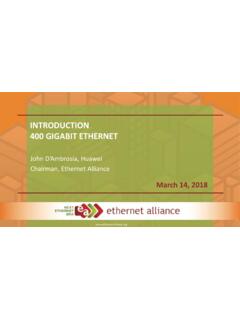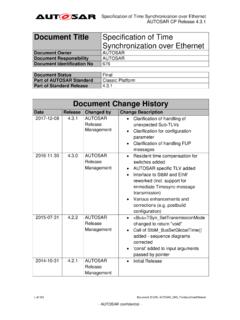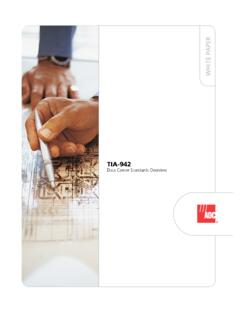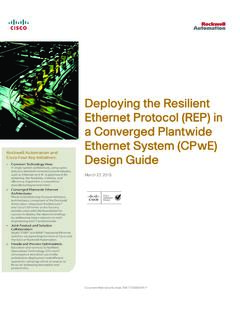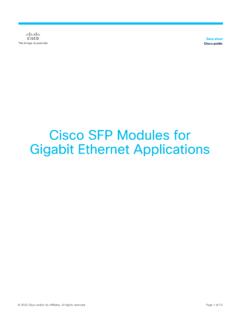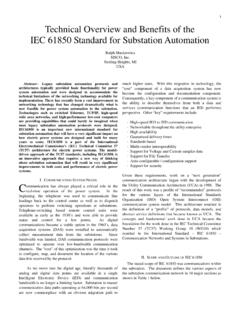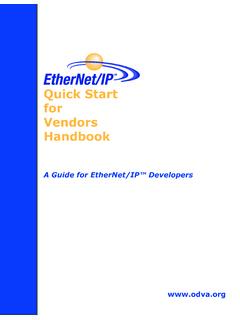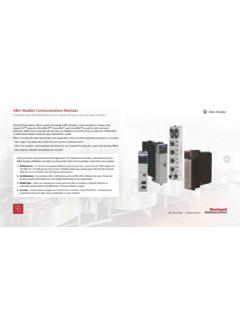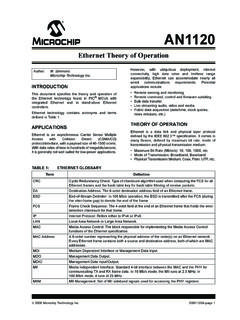Transcription of Overview of IEEE802.3bt Power over Ethernet with Dual ...
1 Yair Darshan, Microchip Dylan Walker, Cisco March 2019 [Rev002e] Overview of Power over Ethernet with dual - signature PDs Overview of IEEE Std -2018 Power over Ethernet with dual - signature PDs Rev002d Page 2 of 30 IEEE Std introduces Clause 145 to the standard and specifies two different but equally interoperable PD configurations: single- signature and dual - signature . and , the PoE standards that preceded IEEE Std -2018, did not define or distinguish between single- signature and dual - signature PDs, so these are important new concepts for designers and manufacturers of PoE equipment. As such, this white paper seeks to serve as a primer for the operation of dual - signature PDs, while the following white paper covers single- signature PDs and the IEEE Std -2018 standard in general: At a high level, a dual - signature PD has two separate detection circuits and two separate classification circuits.
2 In contrast, a single- signature PD has a single detection circuit and a single classification circuit. Another characteristic that distinguishes dual - signature PDs from single- signature PDs is supported load configurations. While both PD variants can be single-load ( each two pairs of the same polarity are connected at some point after the diode bridge, as shown in Figure 1, only a dual - signature PD can be dual -load by keeping isolation between each two pairs of the same polarity as shown in Figure 2. PSE( Power Sourcing Equipment)PD Detection and Classification PD Detection and Classification dual - signature PDMode AMode BLink section( the network cable)Load Figure 1: High-level block diagram of a PoE system with a single-load dual - signature PD PSE( Power Sourcing Equipment)PD Detection and Classification PD Detection and Classification dual - signature PDMode AMode BLink section( the network cable)Load ALoad B Figure 2.)
3 High-level block diagram of a PoE system with a dual -load dual - signature PD dual - signature PDs enable applications that require up to the same maximum Power level as single- signature PDs, but with the additional flexibility of different load configurations and either a parallel or staggered Power -up sequence across Modes. The following are typical applications for dual - signature PDs: A PD that consists of two independent, isolated loads with distinct Class requested over each Mode. A PD that consists of two independent, isolated loads with the same Class requested on both Modes and where only one of the loads is operating while the other provides redundancy. Introduction to IEEE Std -2018 dual - signature PDs Overview of IEEE Std -2018 Power over Ethernet with dual - signature PDs Rev002d Page 3 of 30 About this document This document provides an Overview of how the IEEE Std -2018 Power over Ethernet standard specifies operation with dual - signature PDs.
4 The focus of this whitepaper is on dual - signature PDs and PSE operation when powering a dual - signature PD. Important differences between dual - signature PDs and single- signature PDs are highlighted where deemed helpful. This document assumes a baseline level of understanding of the standard that can be attained by first reading the following excellent EA white paper: The information herein is based on the published version of the standard: IEEE Std -2018. While every effort is made to provide correct information, there is always the inherent risk of unintentionally deviating from what the specification actually says. Thus, this white paper is intended to help understand dual - signature operation and requirements, but should not be used in lieu of the standard.
5 IEEE Std -2018 is available from When information is presented in tabular form, an "X" means "not supported", while " " indicates support. Also, unless specifically mentioned otherwise, references to PSE and PD without a specified Type refer to Type 3 and Type 4 devices. This document has been prepared by Yair Darshan (Microchip PoE Chief R&D Engineer, IEEE DTE Power via MDI over 4-Pair Task Force member) and Dylan Walker (Principal Engineer, Enterprise Switching, Cisco and IEEE DTE Power via MDI over 4-Pair Task Force member). The views being presented in this educational material on the respective IEEE standards under consideration are the views of the author(s), and do NOT represent a formal position or interpretation of the respective standard by The Ethernet Alliance.
6 This document is provided on an AS IS, AS AVAILABLE, and with ALL FAULTS basis, with no representations or warranties whatsoever, whether express, implied, statutory, at common law, or otherwise. See additional information at the end of the document on page major section in the document highlights the relevant portions in the IEEE Std -2018 standard by listing these in a green box at the beginning of the section. Overview of IEEE Std -2018 Power over Ethernet with dual - signature PDs Rev002d Page 4 of 30 1. A dual - signature system Overview .. 6 Type .. 6 Class .. 7 High-level operation .. 7 2. Detection .. 8 3. Connection check .. 8 dual - signature PD configuration.
7 9 4. Classification .. 9 Classification 12 Class probing .. 12 Mutual identification .. 13 DLL classification .. 13 5. Autoclass .. 15 6. Inrush .. 15 PSE inrush .. 16 dual - signature PD inrush .. 16 7. Operating Power .. 18 dual - signature PD Power limits .. 18 PSE Power when connected to a dual - signature 20 PSE current limiting .. 22 Powering configurations .. 22 PD reflected voltage .. 23 PSE reverse 24 8. Current unbalance in dual - signature PDs .. 24 dual - signature PD current unbalance .. 26 9. Maintain Power signature (MPS) .. 26 PSE MPS measurements .. 27 dual - signature PD MPS design considerations .. 28 10. Summary comparison of single- and dual - signature PDs .. 29 Legal disclaimer.
8 30 Contents Overview of IEEE Std -2018 Power over Ethernet with dual - signature PDs Rev002d Page 5 of 30 List of Figures Figure 1: High-level block diagram of a PoE system with a single-load dual - signature PD .. 1 Figure 2: High-level block diagram of a PoE system with a dual -load dual - signature PD .. 2 Figure 3: Power over Ethernet system with dual - signature PD .. 6 Figure 4: Typical startup procedure for a PSE operating with a dual - signature PD .. 7 Figure 5: Conceptual diagram of a dual - signature PD .. 9 Figure 6: Physical Layer classification with Type 4 dual - signature PD with requested Class 5 on Mode A .. 12 Figure 7: Physical Layer classification with Type 4 dual - signature PD with requested Class 3 on Mode B.
9 12 Figure 8: PSE inrush current per pairset for a dual - signature PD, IInrush-2P .. 16 Figure 9: dual - signature PD inrush time phases per pairset .. 16 Figure 10: PD input average Power and peak Power for single- signature and dual - signature PD .. 19 Figure 11: dual - signature Power sequence delay range .. 20 Figure 12: Type 3 PSE operating current template .. 21 Figure 13: Type 4 PSE operating current template .. 21 Figure 14: 2-pair operating Power configuration .. 24 Figure 15: 3-pair operating Power configuration .. 24 Figure 16: Overview of pair-to-pair current unbalance with a single-load dual - signature PD .. 25 Figure 17: Overview of the lack of pair-to-pair current unbalance for a dual -load dual - signature PD.
10 25 Figure 18: PD MPS requirements for a dual - signature PD .. 27 List of Tables Table 1: Supported Classes for a given PSE Type .. 6 Table 2: PSE Type Overview when connected to a dual - signature PD .. 6 Table 3: dual - signature PD Type Overview .. 7 Table 4: Power Classes per pairset defined by IEEE Std -2018 for dual - signature PDs .. 7 Table 5: PSE Type and corresponding maximum number of class events and assigned Class .. 10 Table 6: PD requested Class and corresponding class signatures .. 10 Table 7: Derivation of assigned Class and Power levels for a PSE and a dual - signature PD .. 11 Table 8: Assigned Class and number of class events based on available PSE Power and the PD s requested Class .. 11 Table 9: Deriving PD Type from the requested 13 Table 10: Relation between negotiated DLL Power and the assigned Class.
